Pros
Cons
Introduction
Overall Design
{{section_header}}{{section.name}}{{/section_header}}
The {{product.model}} is a typically good looking Samsung TV. The bezel has a high gloss finish that tapers from black to clear. The whole thing is imbued with Samsung's touch of color, though identifying the color proved elusive. (There's no description on Samsung's website.) We'll call it umber. It collects a lot of fingerprints, which can be a problem if you intend to use the TV controls along the bottom of the bezel. The panel meets the base in an attractive, cylindrical neck that allows the panel to swivel back and forth.
Front
{{section_header}}{{section.name}}{{/section_header}}

Back
{{section_header}}{{section.name}}{{/section_header}}

Sides
{{section_header}}{{section.name}}{{/section_header}}

Stand/Mount
{{section_header}}{{section.name}}{{/section_header}}
The stand is plenty solid, and allows the panel to swivel back and forth.
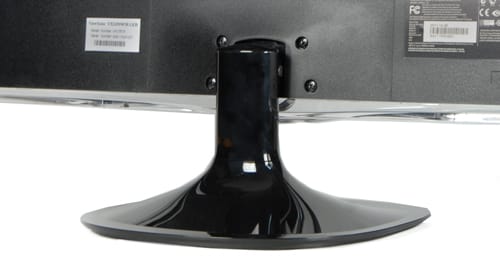
Remote Control
{{section_header}}{{section.name}}{{/section_header}}
The remote control that ships with the {{product.name}} is standard issue and familiar to anyone that's owned a Samsung TV for the last few years. The overall design is comfortable and the buttons are sensibly laid out. It's not flashy, but it works very well.
If you're feeling fancy, the {{product.name}} is one of a few Samsungs this year that can be controlled by iOS and Android devices if you download the app. Unfortunately, they'll only connect over WiFi, so you need to make the additional purchase of a WiFi dongle ($80 on Samsung's website).
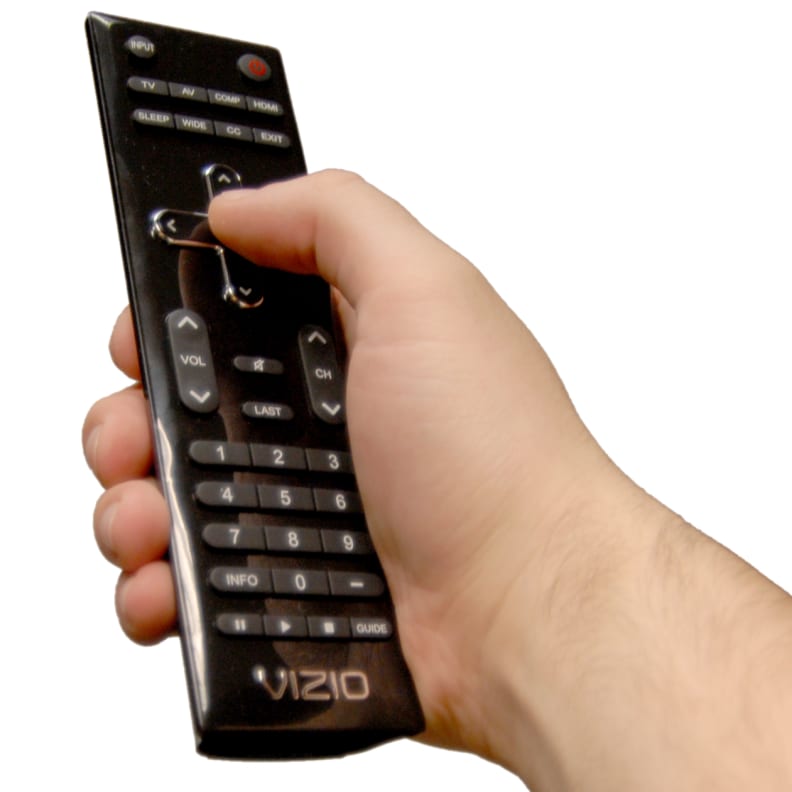
In the Box
{{section_header}}{{section.name}}{{/section_header}}
The {{product.name}} ships with the remote control, batteries, the stand, and some basic documentation. There's no print manual, just a quick "getting started" guide. The manual is electronic, built into the TV and available for download. It's terrible.
You'll be glad to hear that as of May 1st, 2011, two pairs of 3D glasses are included with the purchase of every Samsung 3D TV. Granted, they're the cheapest versions of the glasses, but at least you don't have to shell out any more money.
Black Level
{{section_header}}{{section.name}}{{/section_header}}
The {{product.name}} managed a decent black level, but it's certainly not as good as the average plasma TV. In fact, the Sony EX720, an LCD TV, managed a better black level. The {{product.name}} isn't terrible, but it's not great either. More on how we test black level.
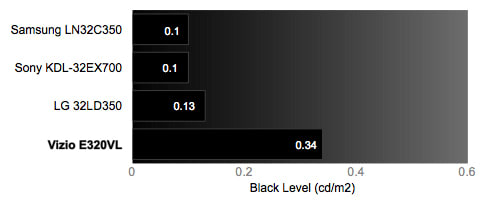
Peak Brightness
{{section_header}}{{section.name}}{{/section_header}}
While we didn't love the {{product.name}}'s black level, the peak brightness was better than a lot of plasmas we've reviewed. It's not great. We want to see peak brightnesses over 200 cd/m 2 if you want to compete with the ambient light of a sunny room. More on how we test peak brightness.
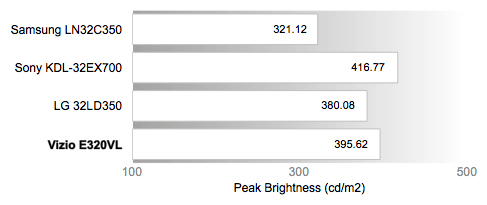
Contrast
{{section_header}}{{section.name}}{{/section_header}}
The {{product.name}}'s contrast ratio was hurt by its less than stellar black level. With a measured contrast of 1942:1, it's pretty good, but not great. As you can see, both the Panasonic (a plasma) and the Sony (an LCD) had wider contrast ratios. More on how we test contrast.
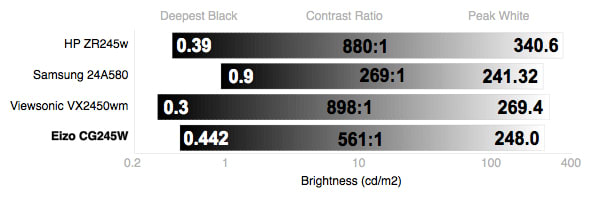
Tunnel Contrast
{{section_header}}{{section.name}}{{/section_header}}
Like many plasmas, the {{product.name}} had a hard time maintaining a consistent black level. An all-black or mostly-black screen will have a much deeper black level than a small area of black surrounded by bright white. LCDs typically don't have this problem. More on how we test tunnel contrast.
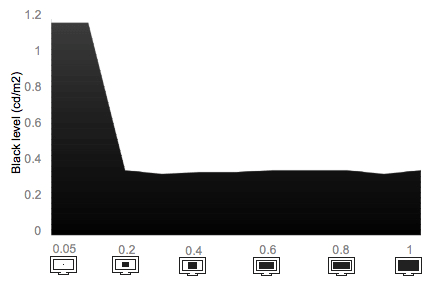
White Falloff
{{section_header}}{{section.name}}{{/section_header}}
The flip-side of the tunnel contrast test, white falloff measures the peak brightness consistency. Again, the {{product.name}} had a hard time, as you can see in the chart below. More on how we test white falloff.
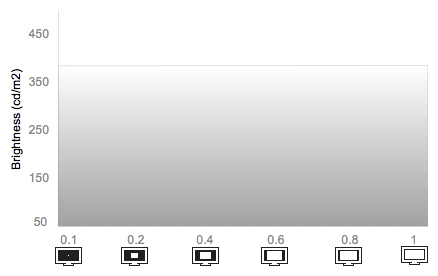
Uniformity
Greyscale Gamma
{{section_header}}{{section.name}}{{/section_header}}
The greyscale gamma test measures how a TV transitions from black to white. Look at the chart below. First, we're looking for a smooth line. The {{product.name}}'s line is not terrible smooth. There's that weird hook in the lower left, which represents the shadow details. It appears that the black level was brighter, then darker, then brighter again. After that, the response smooths out (with a few kinks). As it approaches the midtones to highlights, the curve becomes more horizontal, which indicates that you'll see fewer values in what should be a smooth gradient.
There's also the slope of the curve to consider. An ideal curve is between 2.1 and 2.2. The {{product.name}} had a curve of 2.03, making it the rare TV that's shallower than ideal (most are steeper). More on how we test greyscale gamma.
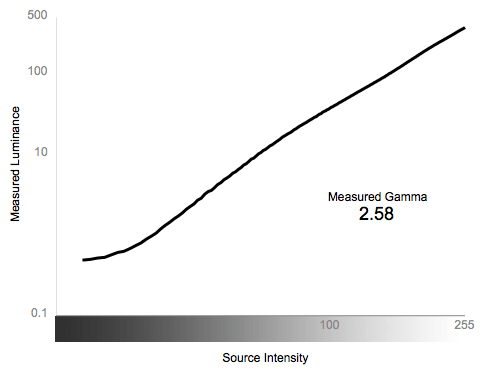
Color Temperature
{{section_header}}{{section.name}}{{/section_header}}
The {{product.name}} did a decent job maintaining a consistent color temperature. If you see the chart below, you can see that the temperature wavers between cool and warm. You won't notice the cool portions, because those fluctuations would be imperceptible. As the signal gets darker, you will notice the whites getting warmer. More on how we test color temperature.
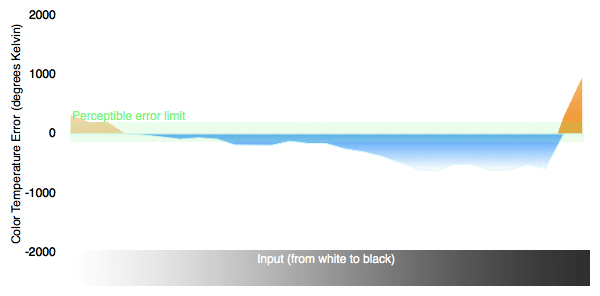
RGB Curves
{{section_header}}{{section.name}}{{/section_header}}
The {{product.name}} did a pretty good job in the RGB color curve tests. The lines aren't terrible smooth, but they do move in relative uniformity. All three channels peak too early, meaning they can't produce detail in the brightest portions of the signal range. More on how we test RGB curves.
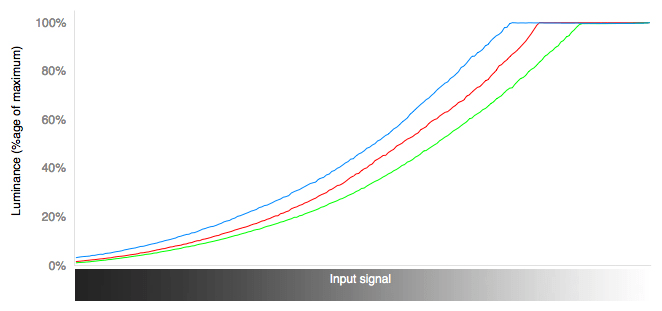
The strips below are digital recreations of the RGB color curve test data, compared alongside three similar TVs, as well as the ideal response curve.
Motion Performance
{{section_header}}{{section.name}}{{/section_header}}
Overall, the motion performance of the {{product.name}} is good, but not amazing. Sure, it's as smooth as any decent plasma TV. It doesn't produce the same color trailing or flickering that we see in a lot LCD TVs. However, images with a lot of fine detail lose a lot of detail when they're in motion. Faces get fuzzy. Textures become flat. If forced to choose, we'll take that over color trailing. You probably won't even notice if you're sitting far enough away. More on how we test motion performance.
3:2 Pulldown & 24fps
{{section_header}}{{section.name}}{{/section_header}}
The {{product.name}} has no problem displaying 24fps content. In order to get the best content, make sure you locate the Film Mode setting in the menu and change the setting from "Auto1" to "Auto2." That should stop most of the artifacting that you get with some 24fps content. More on how we test 3:2 pulldown and 24fps.
Resolution Scaling
{{section_header}}{{section.name}}{{/section_header}}
The {{product.name}} has a native resolution of 1080p. Anything of a lower resolution has to be upconverted by the TV's internal processing to fit the screen. Overall, the TV is good at this task. First, you want to locate the settings that control the screen fitting. There's a dedicated button on the remote labeled "P Size" that does just this. For 1080p, 1080i, and 720, use the setting called "Screen Fit.' More on how we test resolution scaling.
480p
With 480p content, the TV loses a lot of video (2% from each side and 3% from the top and bottom) due to overscan. That's quite a lot – enough to obscure necessary onscreen text, like your cable menu.
720p
The 720p content showed no overscan issues, but did have a hard time with some high contrast, high frequency patterns that create Moires.
3D Effect & Experience
{{section_header}}{{section.name}}{{/section_header}}
As with the Panasonic 3D plasmas we've reviewed this year, the {{product.name}} makes good use of its active shutter 3D system. The effect ranges from mediocre to good (home 3D has yet to achieve a word as strong as "great"). The most effusive we're willing to extend so far is that our eyes did not hurt after 15 minutes. That's actually quite an achievement.
You'll see in the individual tests below that 3D performance is quite different from 2D, even on the same TV. Overall, though, we were pleased with what we saw.
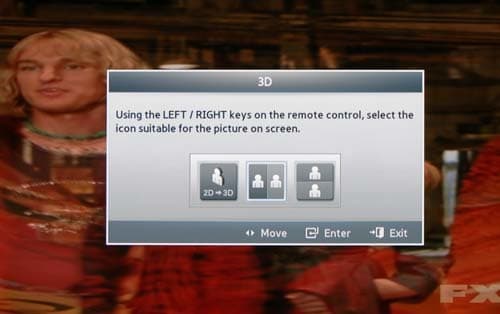
Some of the options in the 3D menu
3D Black & White
{{section_header}}{{section.name}}{{/section_header}}
It should come as no surprise that the {{product.name}} loses a lot of contrast when in 3D mode. It's not the display, it's the tinted 3D glasses that cause the problem. As a result, the contrast ratio goes from 1942:1 all the way down to 138:1.

3D Color
{{section_header}}{{section.name}}{{/section_header}}
The {{product.name}} performed surprisingly well in the color tests when in 3D mode, but the color temperature test was the worst performance of the three. As you can see, the whites get much warmer, then cooler, than warmer again. It's just not consistent.
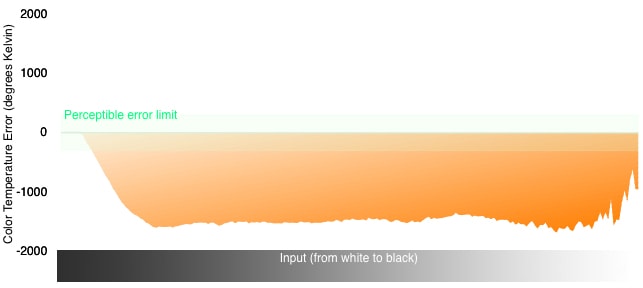
The {{product.name}}'s RGB curve response was nearly as good in 3D as it was in 2D. The blue channel peaked much earlier, but we liked the performance overall.
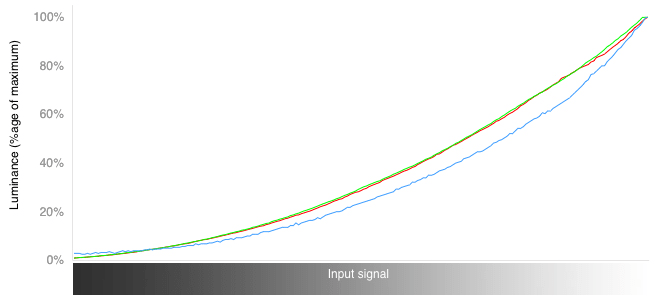
The {{product.name}}'s 3D performance didn't match up quite as well to the rec. 709 color standard as it did in the 2D performance. The green point is oversaturated, but everything else is decent.
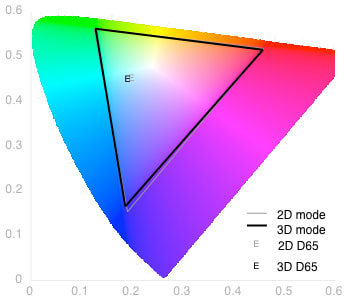
3D Crosstalk
{{section_header}}{{section.name}}{{/section_header}}
3D works by sending slightly different images to the left and right eyes. Crosstalk is the phenomenon of data leaking into the wrong eye. It's probably the biggest issue that causes a breakdown in the "3D effect." Fortunately, the {{product.name}} does a good job staving off crosstalk. The biggest problems areas were shots with white on grey and white on black. In those instances, you'll get a lot of content bleeding into the wrong eye. Overall, though, the {{product.name}} performed better than most of the 3D TVs we've reviewed to date.
3D Glasses
{{section_header}}{{section.name}}{{/section_header}}
The {{product.name}} uses the active shutter 3D technology, which is certainly more expensive than passive (aka "Cinema 3D"), but we find that effect is typically better, especially on a plasma TV. All 3D Samsung TVs ship with two free pairs of glasses (limited time offer, read here for details). Samsung has also dropped the price of its most basic 3D glasses down to $50 per pair, so you can load up the whole family for a lot less than you could this time last year.

Not to miss an opportunity to upstage the neighbors, you can forget about the free glasses and opt for the newer, lighter, cooler looking ultralight glasses. They'll run you $150 per pair (that's the previous cost of the standard glasses).
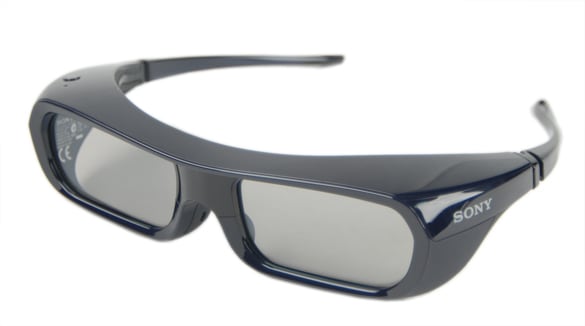
Yes, you will look like a dork with these on
Formats
{{section_header}}{{section.name}}{{/section_header}}
The {{product.name}} has a native resolution of 1080p (1920 x 1080), but it can handle all standard NTSC formats.
Viewing Angle
{{section_header}}{{section.name}}{{/section_header}}
The {{product.name}} has a great viewing angle, like nearly all plasma TVs. In fact, it's identical to the Panasonic we pulled in for comparison. As is typical, LCD TVs like the Sony and the LG could not compete.
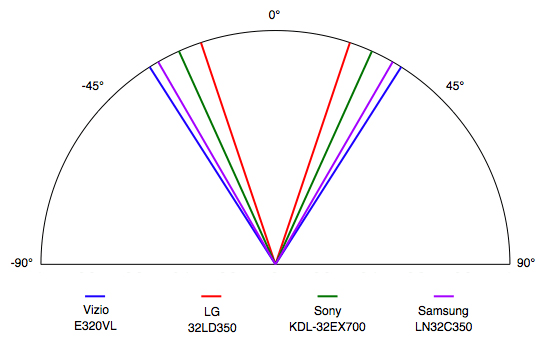
Reflectance
{{section_header}}{{section.name}}{{/section_header}}
Plasma TVs use a glass panel rather than acrylic, so they tend to reflect a lot more light. Samsung has done what it can to minimize glare, but if you're in a sunny room and watching a dark scene, it's like looking into a mirror. No worse than most plasmas, but no better, either.
Video Processing
{{section_header}}{{section.name}}{{/section_header}}
The {{product.name}} has a small handful of video processing features.
Calibration
{{section_header}}{{section.name}}{{/section_header}}
Once you put the {{product.name}} in Movie mode, most of the work is done for you. The bulk of the special features are disabled. You'll only need to make the changes detailed in the table below.

All of our calibration is done in conjunction with the DisplayMate software.
](http://www.displaymate.com/)
Video Modes
{{section_header}}{{section.name}}{{/section_header}}
There are just three video modes on the {{product.name}} (along with a fourth setting used when a PC is connected).
Connectivity
{{section_header}}{{section.name}}{{/section_header}}
The {{product.name}} is equipped with almost all the ports you want in a high-end TV. But it's not a high-end TV. It's a higher-end TV. As such, you get plenty of the basic AV connections: four HDMIs, one component AV input, one shared component/composite AV input, and a VGA with paired 1/8th-inch audio.
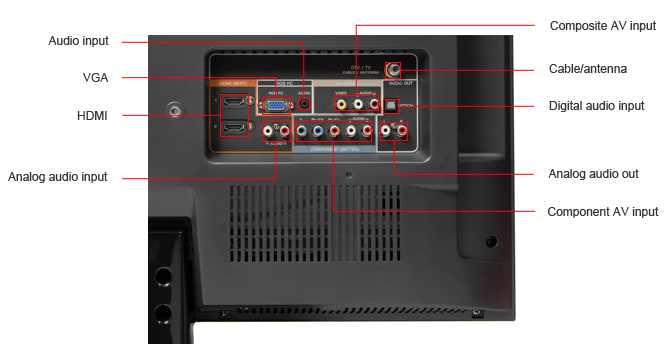
The "local" network of connectivity options expands out from there. You get two USB ports for playing media from USB mass storage devices. You can also use the LAN port or optional WiFi (separate purchase required) to connect to a DLNA home network.
But that's all you can do with the LAN and WiFi, which is a shame. Samsung has a truly great selection of streaming content and apps, but you get no access to them, sorry.
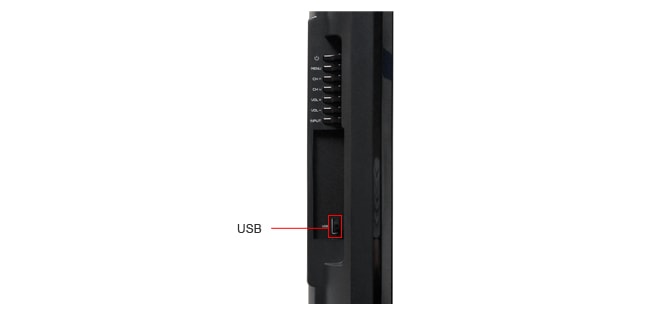
Placement
{{section_header}}{{section.name}}{{/section_header}}
The ports are arranged in an L-shape on the back of the {{product.name}}. Most face out from the back, but some face out to the side. Everything is well labeled and the swivel base allows you to better access the ports.
Audio Quality
{{section_header}}{{section.name}}{{/section_header}}
The {{product.name}} does not have superior audio performance, but it gets the job done if you're not too picky. There are, however, plenty of options in the menu to tweak the audio. There are five audio modes: Standard, Music, Movie, Clear Voice, and Amplify. If you're in Standard mode, you have access to a five-channel equalizer. You'll also find two special features called SRS TruSurround HD (the standard surround sound emulator) and SRS TruDialog. Nothing you do will make this sound like a true surround sound system, but you can try.
Menu Interface
{{section_header}}{{section.name}}{{/section_header}}
The {{product.name}} has the same menu (more of less) that Samsung TVs have used for the last few years. The submenu headers and items are arranged in a sensible, vertical list – no cluttered eye candy or overly clever design. They understand what works and we thank them for it.
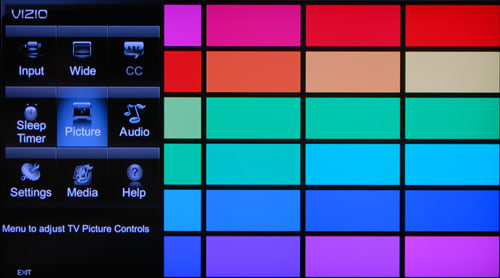
If you get lost in a menu or simply need to go back a step, the Return and Exit buttons are easily accessible on the remote.
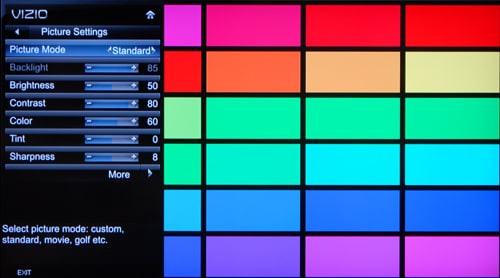
Instruction Manual
{{section_header}}{{section.name}}{{/section_header}}
The {{product.name}} has one of the worst instruction manuals we've seen in some time. There's no print version, but we can live with that. There are both ecological and economic reasons to skip paper, especially when you can just download it (here, by the way). But to replace it with this is just a disservice to your customers. The "e-manual" is loaded onto the TV itself, and is available for download as a PDF. There are no tour photos that describe the exterior features of the TV. There are no specs. The text is white on black, causing eyestrain. The keyword search function is extremely awkward using the remote control, and there's no index at the end that would allow you to scan a list of keywords and jump to that point in the manual. Try again, Samsung.
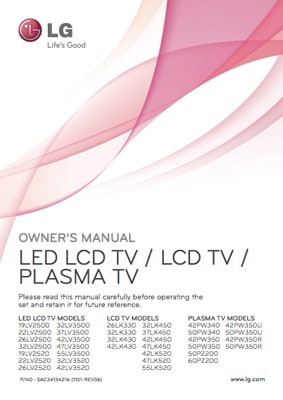
A manual for so many TV models, they have to be further categorized by type.
Internet Features
{{section_header}}{{section.name}}{{/section_header}}
The {{product.name}} has a LAN port and the option for WiFi (with the purchase of a $79 USB adapter). However, these will only connect you to a DLNA home network. The Samsung plasma D550 series does not allow you access their online content, streaming services, or apps store. Sorry.
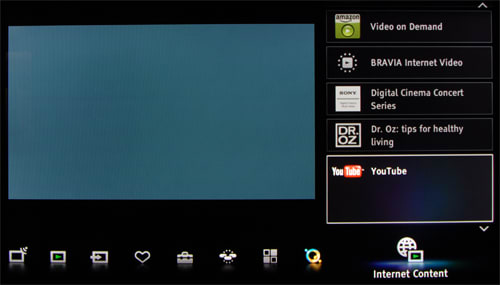
Local Media Playback
{{section_header}}{{section.name}}{{/section_header}}
The {{product.name}} has two USB ports that can play photos, video, and music files from USB mass storage devices. The interface is straightforward enough so even n00bs shouldn't have too hard a time with it. You can create slideshows, playlists, and the rest. Most mid-range TVs and higher have this feature, though we're certainly wondering how much use they get.

Power Consumption
{{section_header}}{{section.name}}{{/section_header}}
The {{product.name}} requires significant power to run. It requires approximately 309 watts to power, which adds up to about $60.34 per year. That's quite a bit more than the latest 2011 plasmas we've been reviewing, and far more expensive than similarly sized LCDs.
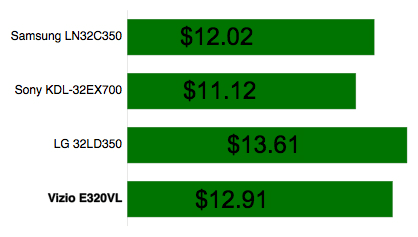
Value Comparison
{{section_header}}{{section.name}}{{/section_header}}
The Panasonic TC-P50ST30 ($1499 MSRP) is a little more expensive than the {{product.name}} ($1299 MSRP). Some of that extra money goes towards performance. The Panasonic has a far better black level and contrast ratio. You also get access to streaming content like Netflix and Skype, while the Samsung is "land locked" to a local DLNA network. On the downside, the Panasonic showed some serious problems with motion performance, as well as trouble displaying high frequency patterns. The 3D performance is tied, more or less. Both are plasma TVs, and produce a much more immersive 3D experience than LCDs.
If you don't need the streaming content, the Samsung will do you just fine.
Blacks & Whites
{{section_header}}{{section.name}}{{/section_header}}
The Panasonic, with its much deeper black levels, produced a far greater contrast ratio than the {{product.name}}. As you can see in the chart below, it's a blowout.

Color Accuracy
{{section_header}}{{section.name}}{{/section_header}}
The color performances of the {{product.name}} and the Panasonic TC-P50ST30 were closely matched. Both had a minor troubles maintaining a consistent color temperature, and both showed fairly good color curves. The Samsung tended to lose more details in the highlights across all three channels. The Panasonic produced smoother color transitions overall, but had some funky business in the brightest reaches of the green channel.
Motion
{{section_header}}{{section.name}}{{/section_header}}
The Panasonic had a very hard time in our motion tests. Anything with fine detail became a fuzzy mess when it moved across the screen. The {{product.name}} was no exemplar of high performance, as it suffered from a minor case of the same problems. Overall, though, the Samsung was superior.
Viewing Effects
{{section_header}}{{section.name}}{{/section_header}}
Both plasma TVs, the {{product.name}} and Panasonic TC-P50ST30 provided excellent viewing angles. In fact, they were nearly identical.
Connectivity
{{section_header}}{{section.name}}{{/section_header}}
The {{product.name}} and Panasonic ST30 differ in their connectivity options. The {{product.name}} has more AV inputs for traditional devices, but the Panasonic offers a media card slot as well as built-in WiFi. Of course, the biggest difference is that the Panasonic ST30 allows you to connect to wider internet for streaming movies and music. The {{product.name}} is a strictly local device that doesn't extend beyond a DLNA home network.
Value Comparison
{{section_header}}{{section.name}}{{/section_header}}
The Sony KDL-55EX720 ($2399 MSRP) costs a lot more than the {{product.name}}. What you get for that money is a very high-end Sony (but not even close to their top of the line). Typically, a larger-screen LCD is going to cost more than a similarly sized plasma. Some people are loyalists to one technology or the other. We see merits in both, but have to give the value win here to the {{product.name}}. For a lot less money you get a lot of screen and rather good performance. The Sony EX720 offers a lot more "bonuses" like a beautiful exterior design, streaming content, and more video processing features.
In terms of 3D performance, the {{product.name}}, along with all the plasma TVs we're reviewed, is a better choice. LCDs like the Sony EX720 tend to create a lot of crosstalk that breaks down the 3D effect.
Blacks & Whites
{{section_header}}{{section.name}}{{/section_header}}
Despite being an LCD, the Sony EX720 offered a better black level than the plasma {{product.name}}. As expected, it also produced a much brighter peak white. That math adds up to a much wider contrast ratio.

Color Accuracy
{{section_header}}{{section.name}}{{/section_header}}
The Sony EX720 was a model of color performance, in most regards. There's virtually no color temperature error, the color curves are smooth, and it matched up well to the rec. 709 color standards. By comparison, the {{product.name}} had some troubles producing bright greens and couldn't match the overall smoothness of the Sony's color gradients.
Motion
{{section_header}}{{section.name}}{{/section_header}}
The Sony EX720 scored better in the motion performance tests because the Motion Flow feature eliminates virtually all the artifacts that can occur with detailed or high contrast objects in motion. However, you may not want to use Motion Flow when watching film-based content, because the extra processing creates a strange effect, making film look like cheap video. The {{product.name}} has a similar feature that created the same problems but offered no improvements to artifacting.
Viewing Effects
{{section_header}}{{section.name}}{{/section_header}}
The Sony EX720, an LCD display, can't match the viewing angle of a plasma like the {{product.name}}.
Connectivity
{{section_header}}{{section.name}}{{/section_header}}
The Sony EX720 has one additional composite AV input, but one less component AV input. The bigger divide is that Sony allows you access to its tremendous collection of streaming content. Of course, it's considerably more expensive than the {{product.name}}.
Value Comparison
{{section_header}}{{section.name}}{{/section_header}}
The LG 47LW6500 ($1699 MSRP) is not cheap, and what it offers compared to the {{product.name}} is pretty clear cut. The online features are greatly expanded. Not only do you get a host of streaming content services, there's also a full internet browser. The interface certainly leaves something to be desired, but who know? Maybe you need internet on your TV. In terms of raw performance, the LG's black level is not great, nor is the contrast ratio. The color performance is good, but not outstanding.
In terms of 3D performance, the LG LW6500 series uses a "passive" system, which is less expensive than the active shutter systems used in a lot of 3D TVs, including the {{product.name}}. We were not terribly impressed with this LG. It was less immersive and you definitely noticed the loss of resolution (one of the most frequently cited complaints about passive 3D.
Overall, if you really dig the online features, maybe it's worth it for you to step up to the LG 47LW6500. Otherwise, the {{product.name}} has slightly better performance for less money.
Blacks & Whites
{{section_header}}{{section.name}}{{/section_header}}
The {{product.name}} handily beat the LG's poor black level, but the LG's peak brightness was far superior. In the final tally, the {{product.name}} has a wider contrast ratio, but not by a huge margin.

Color Accuracy
{{section_header}}{{section.name}}{{/section_header}}
Typically, the LGs that we've reviewed produce tremendous scores in the color tests. The 47LW6500 did well, but not stellar. It maintained a great color temperature, but in our RGB color curve tests it proved to have a hard time producing details in the brightest stretches in the signal range. It was on par, more or less, with the {{product.name}}.
Motion
{{section_header}}{{section.name}}{{/section_header}}
The LG's motion performance was marred by judders, color trailing, and a general lack of smoothness. The {{product.name}} was not perfect but certainly better.
Viewing Effects
{{section_header}}{{section.name}}{{/section_header}}
The {{product.name}}, as a plasma TV, far outstripped the LG 47LW6500 in viewing angle.
Connectivity
{{section_header}}{{section.name}}{{/section_header}}
The LG is nearly identical to the {{product.name}} in terms of connectivity.
Conclusion
The {{product.name}} offers solid color performance, a great viewing angle, and great local media features, all wrapped in an elegant design. It's certainly not the best Samsung plasma, but it does offer a lot of value for the money. The inclusion of 3D is yet another attempt to entice us to love 3D. We don't love 3D, but we readily concede that plasmas have a distinct advantage over LCD when it comes to active shutter 3D technology. Given that Samsung is now offering two pairs of 3D glasses with any purchase of a 3D TV, the pot is definitely sweetened.
As for its downsides, the {{product.name}} does not produce the deep black levels that plasmas should be capable of. As a result, the contrast ratio disappointed. The TV is also a power eater, so be prepared to see a slight bump in your electricity bill. The {{product.model}} is yet another Samsung that teases us with LAN and optional WiFi, only to limit its connectivity to local DLNA networks. Samsung has seriously bulked up on its streaming content and app store, but you won't see any of it with this TV. Why dangle the ports in front of us while denying their full potential?
Overall, we really like the value the {{product.model}} offers for the price tag. Similar TVs are more generous in their online content offerings, but you pay for it. If that's not a dealbreaker for you, this might be a great choice.
Model Series Comparison
{{section_header}}{{section.name}}{{/section_header}}
The PNxxD550 series has three models, 51, 59, and 64 inches. All three offer 3D display, DLNA support, and two USB ports that support video, music, and photo playback.
Photo Gallery
{{photo_gallery "Front Tour Image", "Back Tour Image", "Sides Tour Image", "Stand Photo", "Controls Photo", "Remote Control Photo", "Connectivity Tour Image 1", "Connectivity Tour Image 2", "Connectivity Extra Photo", "Menu Main Photo", "Menu 2 Photo", "Internet Features 1 Photo", "Internet Features 2 Photo", "Internet Features 3 Photo", "Local Media Playback 1 Photo", "Local Media Playback 2 Photo"}}
Ratings & Specs
{{manufacturer_specs_table}}
Meet the tester
David Kender oversees content at Reviewed as the Editor in Chief. He served as managing editor and editor in chief of Reviewed's ancestor, CamcorderInfo.com, helping to grow the company from a tiny staff to one of the most influential online review resources. In his time at Reviewed, David has helped to launch over 100 product categories and written too many articles to count.
Checking our work.
Our team is here to help you buy the best stuff and love what you own. Our writers, editors, and experts obsess over the products we cover to make sure you're confident and satisfied. Have a different opinion about something we recommend? Email us and we'll compare notes.
Shoot us an email